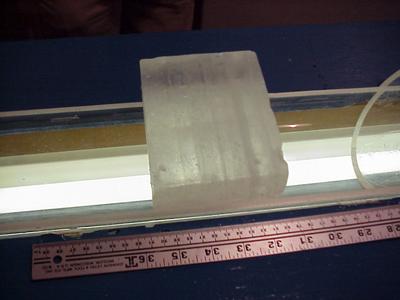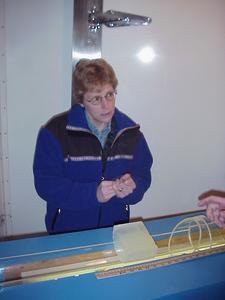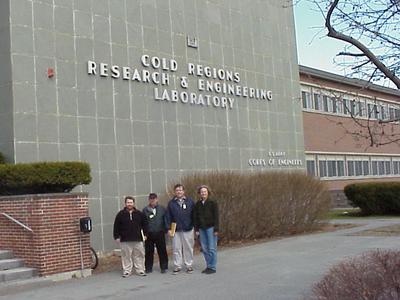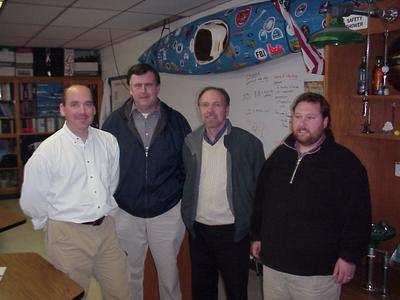
|
|
10 April, 2002
What a wonderful day we had! My Arctic mentor/colleague group left Vermont
early in order to arrive at CRREL (the Cold Regions Research and
Engineering Laboratory) for a tour at 9:15. We atarted by visiting Dr. Deb
Meese, TEA Co-Principal Investigator and Arctic Program Director. We went
right into a cold room where we saw a 63,000 year old piece of ice from a
Greenland ice core. (Check out the pictures below.) The core, completed
in 1992, went down 3,052 meters. By looking at the ice rings (each
"doublet" of summer and winter rings = one year) scientists calculated that
the ice at the bottom of the core is 200,000 year old! Everyone seems to
talk of global warming these days. Did you know that 12,000 years ago the
earth's temperatures shifted up by 7-15 degrees in a two-three year period?
That shift has been documented in ice cores from all around the world, and
scientists are attempting to find out why it occurred. In addition to
analyzing past temperatures and climate changes, ice cores can be used in a
number of other investigations. For example, scientists can trace the
amounts of lead found in the ice in Greenland. Lead is not deposited
naturally, but it began to accumulate once we began using leaded gasoline.
When we stopped using leaded qas in the '1970's, the amount of lead in the
Greenland ice dropped back to zero.
One interesting note from our visit to CRREL is that we found out that you
don't have to be a Ph.D. scientist to experience the excitement of research
in Antarctica and the Arctic. Many graduate students (think of disciplines
such as geology, chemistry, glaciology, gas analysis)have the opportunity
to travel with the research expeditions. Adiditionally, the research sites
often need carpenters, mechanics, cooks, and others who are there to keep
things running smoothly.
After our tour of CRREL and a quick lunch, we visited with Kevin Lavigne,
Antarctic TEA from 2001. Be sure to check out his journals and photos on
the TEA website. Kevin is teaching at Hanover High School where his
students benefit from his amazing travels and research experiences. Kevin
kindly spent his afternoon with us, talking about the research he did and
answering all our questions about Antarctica.

This is what a 63,000 year old piece of ice looks like! Check out the doublets, winter and summer rings that represent one year.

Dr. Deb Meese points out features of this piece of the Greenland ice core.

Here we are in front of the Cold Regions Research and Engineering Laboratory (CRREL) in Hanover, NH. Left to right are Dana Cummings, John Gazo, Peter Gustafson, and me.

Here we are in Kevin Lavigne's classroom in Hanover HS in Hanover, NH. Left to right are Kevin Lavigne (TEA 2001), Peter Gustafson (middle grades social studies teacher), John Gazo (grades 4/5 teacher), and Dana Cummings (6th grade math and science teacher).
Contact the TEA in the field at
.
If you cannot connect through your browser, copy the
TEA's e-mail address in the "To:" line of
your favorite e-mail package.
|
